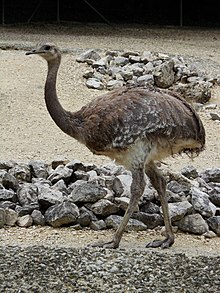Rhea tarapacensis
| Darwin's rhea | |
|---|---|
 |
|
| At Zurich Zoo, Switzerland | |
| Scientific classification | |
| Kingdom: | Animalia |
| Phylum: | Chordata |
| Class: | Aves |
| Order: | Rheiformes |
| Family: | Rheidae |
| Genus: | Rhea |
| Species: | R. pennata |
| Binomial name | |
|
Rhea pennata d'Orbigny, 1834 |
|
| Subspecies | |
|
R. p. garleppi (Chubb, 1913) |
|
 |
|
| Synonyms | |
|
Rhea macrorhyncha |
|
R. p. garleppi (Chubb, 1913)
R. p. tarapacensis (Chubb, 1913)
R. p. pennata (d'Orbigny, 1834)
Rhea macrorhyncha
Pterocnemia pennata
Pterocnemia darwinii
Rhea darwinii
Rhea nana
Pterocnemia tarapacensis garleppi
The Darwin's rhea (Rhea pennata), also known as the lesser rhea, is a large flightless bird, but the smaller of the two extant species of rheas. It is found in the Altiplano and Patagonia in South America.
The lesser rhea stands at 90 to 100 cm (35–39 in) tall. Length is 92 to 100 cm (36–39 in) and weight is 15 to 28.6 kg (33–63 lb). Like most ratites, it has a small head and a small bill, the latter measuring 6.2 to 9.2 cm (2.4 to 3.6 in), but has long legs and a long neck. It has relatively larger wings than other ratites, enabling it to run particularly well. It can reach speeds of 60 km/h (37 mph), enabling it to outrun predators. The sharp claws on the toes are effective weapons. Their feathers are similar to those of ostriches, in that they have no aftershaft. Their plumage is spotted brown and white, and the upper part of their tarsus is feathered. The tarsus is 28 to 32 cm (11 to 13 in) long and has 18 horizontal plates on the front.
It's known as ñandú petiso, or ñandú del norte in Argentina where the majority live. Other names are suri and choique. The name 'ñandú' comes from the greater rhea's name in Guaraní, ñandú guazu, meaning big spider, possibly in relation to their habit of opening and lowering alternative wings when they run. In English, Darwin's rhea gets its scientific name from Rhea, a Greek goddess, and pennata means winged. The specific name was bestowed in 1834 by Darwin's contemporary and rival Alcide d'Orbigny who first described the bird to Europeans, from a specimen from the lower Río Negro south of Buenos Aires, Argentina. As late as 2008, it was classified in the monotypic genus Pterocnemia. This word is formed from two Greek words pteron, meaning feathers, and knēmē, meaning the leg between the knee and the ankle, hence feather-legged, alluding to their feathers that cover the top part of the leg. In 2008, the SACC subsumed Pterocnemia into the genus Rhea.
...
Wikipedia

